Part II: "The Human Being" - The Mechanisms in Our Body
In many verses of the Qur’an, Allah calls our attention to the creation of man and invites people to ponder on this creation: "O man! What has deluded you in respect of your Noble Lord? He Who created you and formed you and proportioned you and assembled you in whatever way He willed." (Surat al-Infitar: 6- 8)
The human being is one of the living beings with the most excellent, sophisticated and amazing systems in nature, whom Allah fashioned in due proportion.
The human body is an amount of flesh and bone of approximately 60-70 kilograms. As is well known, flesh is one of the most fragile materials in nature. When left in the open, it decomposes within a couple of hours, becomes maggoty within a few days and starts to stink unbearably. This feeble substance constitutes a large part of the human body. However, it is maintained without being spoilt, and without decaying, for about 70-80 years by means of the blood circulation that feeds it, and by the skin that protects it from external bacteria.
On the other hand, the skills of the body are very impressive. Each one of the five senses is a miracle. Man gets to know the external world through these senses, and lead his life peacefully thanks to the wholeness of these senses. Details that we encounter as we survey the senses of sight, smell, touch, hearing and taste and their flawless designs are each pieces of evidence that prove the being of the Creator.
The miraculous structures of the human body are not limited to the five senses. Each of the organs facilitating our lives is a separate miracle. They all function just to meet our needs. Let's just imagine how hard life would be if we were created without hands. What would happen if we did not have legs, or if our bodies were covered with thorns, scales or a hard outer layer, instead of skin?
Moreover, the existence of complex systems in the human body, such as respiration, feeding, reproductive and defence mechanisms, and the aesthetics of the human body are each separate wonders.
As seen, there are many delicate balances in the human body. The perfect relation of the entirely interdependent systems to the other systems in the body enables man to carry on his vital functions without problem.
Moreover, he does all these without spending any extra effort, or facing any difficulties. Most of the time, the person does not even become aware of all that happens. Man is not aware of many things: the time when digestion starts or ends in his stomach, the rhythm of his heart, the blood’s carrying exactly the required material to exactly the right places, and his seeing and hearing.
A flawless system has been established in the human body and it works perfectly. This is the creation of Allah, Who regulates all affairs from the heavens to the earth. Allah creates everything, every detail and every living being in the universe. The design we confront when we closely examine the human body is evidence of the uniqueness and flawlessness of Allah’s art of creation.
Allah draws our attention to the perfection in the universe in Surat al-Mulk:
He Who created the seven heavens in layers. You will not find any flaw in the creation of the All-Merciful. Look again - do you see any gaps? Then look again and again. Your sight will return to you dazzled and exhausted! (Surat al-Mulk: 3-4)
A few of the millions of delicate balances in the human body are as follows:
The five senses are arranged entirely according to the human’s needs. For instance, the ear can only sense those sound vibrations that are within certain limits. At first glance, to hear within a larger range might seem more advantageous, yet these sensory limits - called the "hearing threshold" - are regulated for a purpose. If we had very sensitive ears, every moment we would have to bear the sound of many noises from the beating of our hearts to the rustling of microscopic mites on the floor. Then, life really would be very irritating for us.
The same "punctuated equilibrium" holds true also for the sense of touch. The nerves sensitive to touch lying under the human skin are made sensitive in the best possible way and are spread all over the body. The nerves are amassed mainly on our fingertips, lips and sexual organs. Comparatively, "less important" regions of the body such as our backs have fewer nerves. This provides great advantages for man. Let us imagine if the contrary was the case: that our fingertips were extremely insensitive, and that the majority of nerves were collected on our backs. Undoubtedly, this would be quite irritating, for while we would not be able to use our hands effectively, we would feel the tiniest substance - for instance, the creases of our shirt - on our backs.
Development of the organs is an example of this "delicate balance". For instance, think about hair and the eyelashes. Although both are ultimately "hair", they do not grow equally in the same period. Suppose that eyelashes grew as fast as our hair. They would impede our sight and go into our eyes, thus harming one of our most vital organs. Eyelashes have a certain length that stays constant. If by any means, such as burning or an accident, they shorten, they then elongate until they reach their "ideal" length and stop again.
Even the shape of the lashes is very important. Since they curl slightly upwards, they do not restrict sight and they give the eyes an aesthetic look. As the lashes grow, they are covered by an unusual oil secreted by specific glands located at the rim of the eyelids. This is why our lashes are not rough and straight like a brush. There is exactly just such a "subtle adjustment" in every spot of the human body.
This punctuated creation is strikingly revealed in the new-born baby as well as in adolescents. For instance, the new-born baby’s skull bones are very soft and can, to a limited extent, move over one another. This flexibility facilitates the emergence of the baby’s head from the womb without harm. If these skull bones were inflexible, during birth they could crack and cause serious damage to the baby’s brain.
With the same flawlessness, all of the organs in a human being develop in harmony with each other in the course of development. For example, in the development of the head, the skull that encases the brain grows along with it. A skull developing comparatively slower than the brain would compress it, and cause death in a short time.
The same balance is true also for other organs such as the heart, lungs and thorax, the eye and eye socket.
For this reason, it is useful to examine the extraordinary structures of our body to see the art and might in the creation. Every part of our body, the structure of which is more perfect than the most advanced factories equipped with the latest technologies, displays the matchless creation of Allah and proves His sovereignty over our entire body.
If we briefly examine the systems and organs in the human body, we will witness intimately the evidence of a flawless and balanced creation.
Digestion
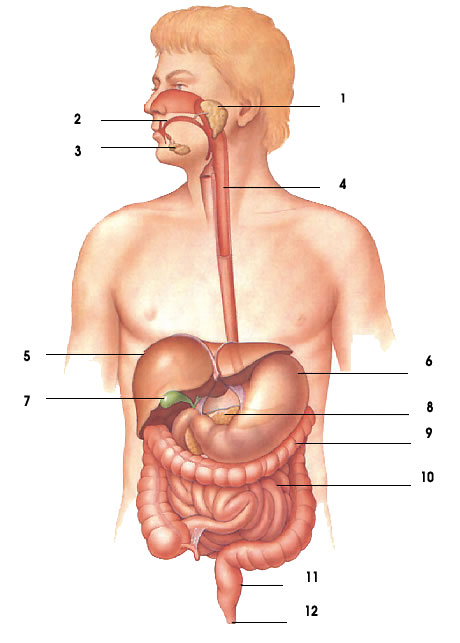 | ||
| 1. salivary glands | 5. liver | 9. large intestine |
| The digestive system is one in which mouth, saliva, stomach, pancreas, liver and intestines operate in harmony and discharge their own functions. If one or more of these complementary organs do not function fully, the whole system becomes locked in stasis. | ||
The saliva that is brought into play right at the beginning of the digestive process, moistens the food so that it can be easily chewed by the teeth and move down the oesophagus with facility. Saliva is also a specialised substance for turning, through its chemical properties, starch into sugar. Just think what would happen if saliva were not secreted in the mouth. We would not be able to swallow anything or even talk because of our dry mouths. We would not be able to eat anything solid, but have to feed on liquids or the like.
There is excellent balance in the system of the stomach. In the stomach, food is digested by the hydrochloric acid therein. This acid is so strong that it could even eat away the stomach walls as well as the food taken in. Yet, a solution is created for man: a substance called mucus, secreted during digestion, coats the stomach walls providing exceptional protection against the disintegrative effect of the acid. Thus, the stomach is prevented from destroying itself. An error in the composition of the mucus could destroy its protective function. There is a perfect match between the acid used for digestion and the mucus secreted to protect the stomach from it.
When the stomach is empty, the secretion that breaks up proteins, that is, foods derived from animals such as meat, is not produced in the stomach. In fact, it exists in the form of a harmless substance without any disintegrative properties. As soon as a protein-containing food enters the stomach, the HCI is secreted in the stomach and breaks this neutral substance down into proteins. Thus, when the stomach is empty, this acid does not injure the stomach that is itself made of proteins.
It is noteworthy that ‘evolution’ can never explain the existence of such a complex system, for it defends the idea that complex structures around us gradually evolved from primitive organisms by the accumulation of small structural improvements. However, it is obvious that the system in the stomach could not have evolved gradually and step-by-step. Absence of even a single factor would bring an end to the organism. One example is sufficient to better understand the inconsistency of the theory of evolution. Think of an organism that wears down its own stomach by the acid it produces there - first its stomach would be destroyed painfully and then its other organs would be consumed by the same acid. The organism would die by eating itself alive.
The liquid in the stomach acquires the capacity to break down proteins after a series of chemical reactions. Think of an organism within the process of evolution, in the stomach of which such a chemical transformation cannot be realised. If the liquid in the stomach of an organism did not acquire the feature of decomposing proteins, that organism would not be able to digest food, and eventually would die with a lump of undigested food in its stomach.
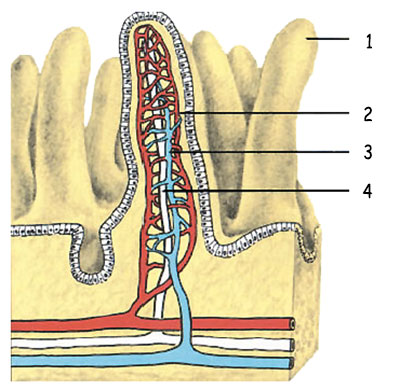 | |
| 1. Villus (pump) | 3. vein |
| A pump (villi) situated in the small intestines that absorbs the necessary materials from the digested food. There are 200 million such pumps in a square millimetre, and each one of them functions every second for the maintenance of our life. In the figure are seen special channels (veins, capillaries, and lymphoid channels) found in the pumps and through which nutrients are absorbed. | |
Let us look at the subject from another point of view. The stomach cells produce the acid in the stomach. Both these cells and other cells in any other part of the body (for instance the cells of the eye) are twin cells originating from the division of the same original single cell in the mother’s uterus. Moreover, both of them have the same genetic information. This means that the data bank of both cells includes genetic information about the proteins needed by the eye and the acid used in the stomach. Yet, submitting to an order coming from an unknown source, among millions of other pieces of information, the eye cell utilises the information belonging to the eye and the stomach cell utilises the information belonging to the stomach. What if the cells of the eye that produce the proteins necessary for the eye (for a reason unknown to us), began to produce the acid used in the stomach - about which they possess the necessary information? If something like that happened, a person would melt and digest his own eye.
Let us continue to examine the amazing balance inside our body:
The rest of the digestive process is equally well planned. The useful part of the food, which has been digested, is absorbed by the lining of the small intestine and diffuses through the blood. The lining of the small intestine is covered with lateral folds that look like a wrinkled cloth. On each fold are smaller folds called "villus". These folds increase immensely the absorptive surface of the intestine. On the upper surface of the cells over the villus are microscopic projections named "microvillus". These projections absorb the food and function as pumps. The interiors of these pumps are connected to the circulatory system through a conveyance system furnished with diverse conveyance routes. This is how the nutrition that has been absorbed reaches the whole body through the circulatory system. Each of the villi has nearly 3,000 microvillus. A 1 mm square area in the lining of the small intestine is covered by approximately 200 million microvillus. In an area of one square millimetre, 200 million pumps work, without breaking down or becoming exhausted, in order to sustain human life. So many pumps, which would normally cover a very large area, are squeezed into a very limited space. This system sustains our lives by ensuring that our body makes maximum use of the food we take in.
Respiration
Respiration is based on delicate balances. Cold or polluted air we breathe may effect our health negatively. For this reason, air should be warmed and cleaned before inhalation. Our nose is created appropriately for this task. The hair and nasal mucus on the walls of the nostrils filter air by capturing dust particles within it. Meanwhile, the air is warmed while travelling through the nostrils. The nasal bones are especially structured so that the air inhaled can go to the lungs only after circulating several times in the nose and thus warming up. The structure that enables air to travel several times within a tiny bone, can only be the outcome of design. If human beings were to try to duplicate this effect, directing the movement of air would only be possible by specific complex calculations. The fact that this special structure exists to meet the needs of another system - namely, cleaning and warming the air travelling to the lungs - is evidence that both systems are specially created by the same Creator. After all these stages, the air arrives in the respiratory tube after being moistened and freed of dust.
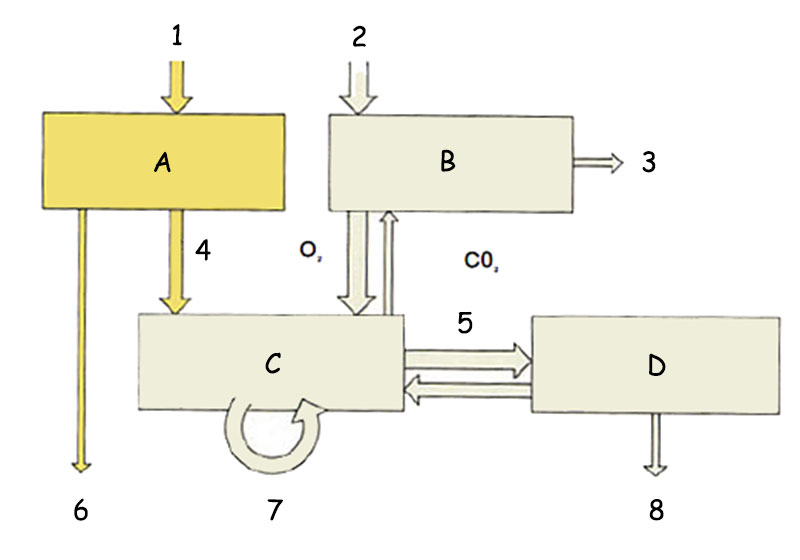 | ||
| A. digestive system | 1. Food and water intake | 5. water and solvents |
| All the systems in the human body (digestive, circulatory, respiratory and excretory systems) work in co-operation and in harmony with each other. In the figure, you may see their interrelation with each other. | ||
Skeleton
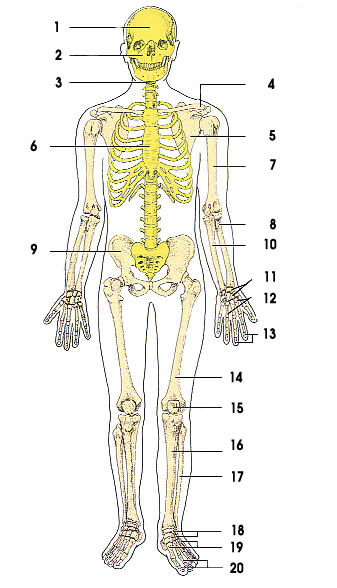 | |
| 1. skull | 11. carpals |
| The skeleton is a real engineering miracle. It is composed of 206 bones. These fused bones furnish the human body with an extraordinary capability of movement. No robot constructed so far can imitate the locomotive ability of the human body. | |
The skeleton is an engineering marvel on its own. It is the structural support system of the body. It protects vital organs like brain, heart and lungs, and upholds the internal organs. It furnishes the human body with a superior capacity for movement that cannot be imitated by any artificial mechanism. Bone tissue is not inorganic as many people think. Bone tissue is the mineral bank of the body that includes many important minerals like calcium and phosphate. In accordance with the needs of the body, it either stores these minerals or delivers them to the body. Besides all these, bones also produce red blood cells.
In addition to the uniformly perfect functioning of the skeleton, the bones constituting it also have an exceptional structure. Having the tasks of bearing and protecting the body, bones are created with the capacity and strength to fulfil this function. The worst conditions possible are taken into consideration as well. For instance, the thighbone can carry a weight weighing a ton when perpendicular. Surprisingly, at each step we take, the bone carries a weight equivalent to three times our body weight. When an athlete pole-vaults and he lands on the ground, every square centimetre of his pelvis is exposed to a pressure of 1,400 kilograms. What makes this structure, which is formed by the division and replication of the single original cell, so strong? The answer to the question is hidden in the unequalled creation of bones.
An example from today's technology would be helpful to further clarify the subject. The scaffolding system is used in the construction of spacious and tall buildings. The support elements of the constructions made with this technique do not have a monolithic structure, but consist of many intersecting rods forming a scaffold. By the help of complex calculations that can only be made by computers, it could be possible to build stronger and more cost-effective bridges and industrial constructions.
The internal structure of bones is similar to that of the scaffold system used in the construction of those bridges and towers. The only important difference is that the system in bones is more complicated and superior to those designed by men. By means of this system, the bones are extremely strong and yet light enough for comfortable use by humans. If the opposite were the case, i.e., if the interior of the bones was hard and full like its exterior, it would be too heavy to be carried by a human and would easily break or crack at the slightest blow due to its rigid and hard structure.
The perfect design of our bones helps us lead our lives very simply, manage to perform even very difficult tasks easily without pain. Another feature of bone structure is its flexibility in certain parts of the body. Just as the rib-cage protects the vital organs of the body such as the heart and lungs, it also expands and contracts to let air move in and out of lungs.
The elasticity of bones may change over time. For instance, in women, the hipbones are extended towards the last months of pregnancy and move apart from each other. This is an extremely important detail, because during birth, this extension allows the baby's head to come out of the mother’s womb without being crushed.
The miraculous aspects of the bones are not limited to these. Besides their flexibility, durability and lightness, the bones also have an ability to repair themselves. When a bone is broken, one only has to keep this bone firm to allow it to repair itself. As is obvious, this, like all other processes in the body, is an extremely complex process in which millions of cells collaborate.
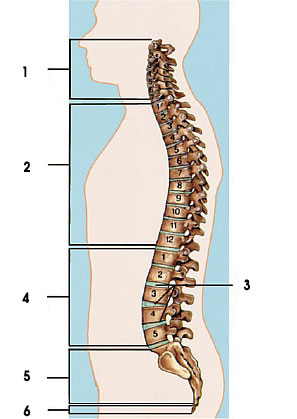 |
| 1. Cervical vertebrae |
| With each step, a force is exerted by the ground on the body as a reaction to the body's weight. If the shock absorbers between the vertebrae did not exist, and if the spine had a straight structure, this force would be transmitted directly to the skull. Consequently, the top of the spine would break into the brain and shatter the skull. |
The locomotive capability of the skeleton is another important detail to consider. With each step we take, the vertebrae making up our backbone move over each other. This continuous movement and friction might normally cause the vertebrae to wear out. In order to prevent this, between each vertebra, resistant cartilages, called ‘disks’, are placed. These disks function as shock absorbers. At each step, a force is exerted by the ground on the body as a reaction to the body’s weight. This force does not do any harm to the body due to the shock absorbers of the backbone and its "force distributing" curved shape. If this flexibility and special structure that reduce the force of reaction did not exist, the released force would be transmitted directly to the skull and the top end of the spine would break into the brain by shattering the skull.
The traces of creation are also visible at the joint surfaces of the bones. The joints do not need to be lubricated although they move continuously for a lifetime. Biologists conducted research to find the reason: how is the friction in joints being eliminated?
Scientists saw that the event was solved by a system that can be regarded as an "absolute miracle of creation". Joint surfaces exposed to friction are covered with a thin, porous cartilage layer. Under this layer is a lubricant. Whenever the bone compresses the joint, this lubricant gushes out of the pores and makes the joint surface slide "as if on oil".
These all show that the human body is the outcome of perfect design, and it is a superior creation. This perfect design helps a human being to make very dissimilar movements with great swiftness and facility.
Just imagine if everything were not so perfect and the entire leg were formed of a single long bone. Then, walking would be a serious problem and we would have very clumsy and idle bodies. Even taking a seat would be difficult, and the leg bone would easily break because of being forced during such acts. However, the human skeleton has a structure that permits all kinds of body motions.
Allah created, and still creates, all the features of the skeleton. Allah invites man, whom He has created, to ponder this:
...Look at the bones -Look further at the bones, how We bring them together and clothe them with flesh... (Surat al-Baqara: 259)
Man must ponder this, appreciate the might of Allah, Who has created him, and be thankful to Him. If he does not do so, he will be in great loss. Allah, Who created the bones and clothed them with flesh, is able to do it again. This is stated in the verse:
Does not man see that We created him from a drop yet there he is an open antagonist! He makes likenesses of Us and forgets his own creation, saying, "Who will give life to the bones when they are decayed?" Say "He Who made them in the first place will bring them back to life. He has complete knowledge of every created thing. " (Surah Yasin: 77-79)
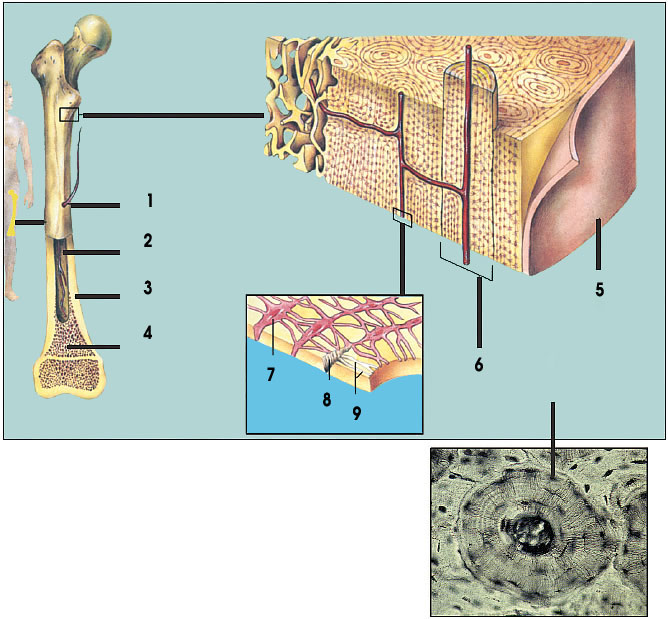 | |
| 1. Food canal (for the entry and exit of blood vessels and nerves in the bone marrow) | |
| 2. Yellow bone marrow | 6. Canals for bone marrow and capillary blood vessels |
| This is the micrograph of the marvellous organisation inside the longitudinal bones of the body. The bones, which produce blood cells and function as the mineral bank of the body, are living. | |
Co-Ordination
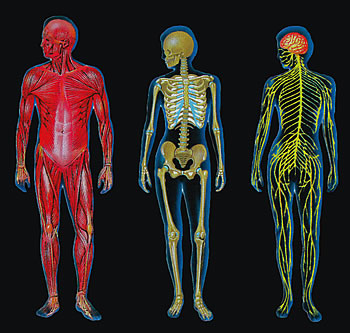 |
| Even one of the systems seen in the picture cannot have been established by coincidence. In addition, it would have no meaning for these systems to form separately one by one. They have to come into existence concurrently in absolute harmony. |
In the human body, all the systems simultaneously work in a co-ordinated way and in full harmony for a definite purpose, namely, to keep the body alive. Even the smallest movements we do everyday, such as breathing or smiling, are outcomes of perfect co-ordination in the human body.
Inside us is an incredibly complicated and comprehensively co-ordinated network that operates without stopping at all. The purpose is the continuance of living. This co-ordination is particularly visible in the locomotive system of the body, because, for even the smallest movement, skeletal system, muscles and nervous system must work in perfect collaboration.
The precondition of co-ordination in the body is correct information delivery. Only by delivering correct information can new assessments be made. For this purpose, a highly developed intelligence web functions in the human body.
In order to perform a co-ordinated act, first, the organs involved in this act and their inter-relations should be known. This information comes from the eyes, the balance mechanism in the internal ear, muscles, joints and skin. Every second, billions of pieces of information are processed, evaluated and new decisions are taken accordingly. Man is not even aware of the processes accomplished in his body at dizzying speed. He just moves, laughs, cries, runs, eats and thinks. He spends no effort in performing these acts. Even for a faint smile, seventeen muscles have to work together at the same time. Non-function or malfunction of even one of these muscles changes the expression on the face. In order to be able to walk, fifty-four different muscles in the feet, legs, hips and back must work in co-operation.
There are billions of microscopic receptors in the muscles and the joints, giving information about the present condition of the body. The messages coming from these receptors reach the central nervous system and new commands are sent to the muscles according to the assessments made.
The perfection of the co-ordination of the body will be better understood with the following example. In order just to lift the hand, the shoulder has to be bent, the front and rear arm muscles - called "triceps" and "biceps" - should be contracted and relaxed, and the muscles between elbow and wrist have to twist the wrist. In every part of the act, millions of receptors in the muscles pass on information immediately to the central nervous system about the position of the muscles. In return, the central nervous system tells the muscles what to do in the next step. Of course one is not aware of any of these processes, but just wishes to lift one’s hand, and does it right away.
For instance, to keep your body straight, many pieces of information derived from billions of receptors in your leg muscles, feet, back, abdomen, chest and neck are evaluated and a similar number of commands are given to the muscles each second.
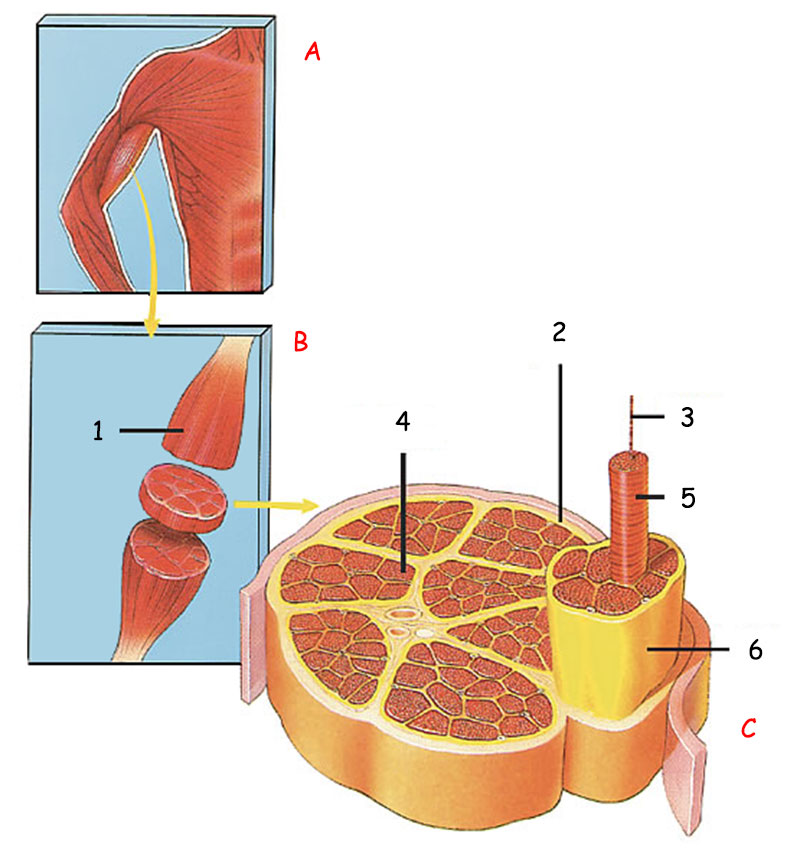 | |
| A. Biceps | 1. biceps |
| The sensors between these fibres transmit information to the central nervous system about the present condition of the muscles. The central nervous system exercises absolute control over the muscles through the information it receives from billions of receptors. | |
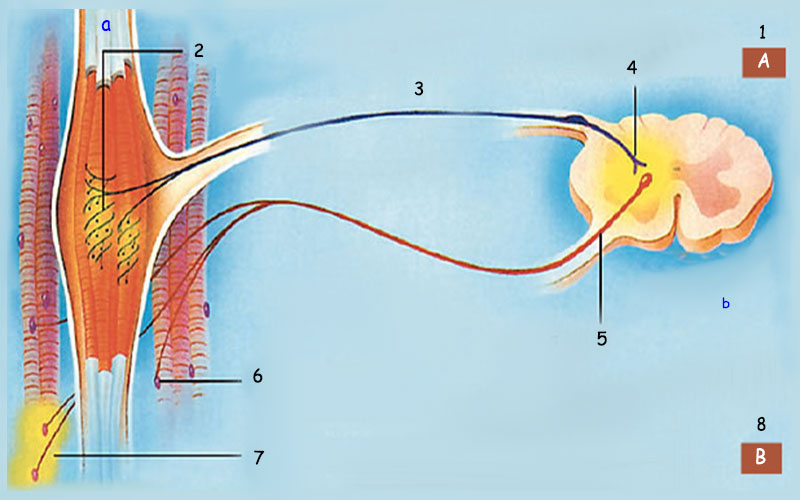 | |
| A. stimulation a. muscle sac | 1. Muscle sac contracts |
| The scheme illustrates the transmission of information from sensors in the muscles to the spinal cord, which in turn gives the muscles new instructions. Each second while you read these lines, billions of pieces of information transmitted by billions of receptors are evaluated and the same number of instructions are given. Man finds himself born into this miraculous system. He, however, has no share either in its creation or even in its operation. | |
Nor do we spend extra effort to speak. Man never plans how far apart the vocal cords should be, how often they should vibrate, in which sequence, how often and which of the hundreds of muscles in mouth, tongue and throat should be contracted and relaxed. Nor does he calculate how many cubic centimetre of air should be inhaled into the lungs, and how fast and in which frequency this air should be exhaled. We could not do this even if we wanted to! Even a single word uttered from the mouth, is an outcome of the collective working of many systems stretching from man’s respiratory system to the nervous system, from the muscles to the bones.
What happens in case of a problem in this co-ordination? Different expressions might appear on our faces when we want to smile, or we might not manage to talk or walk when we want to. However, we can smile, talk, walk anytime we want and no problems occur, because everything mentioned here is accomplished as a result of the fact of Creation which logically requires "infinite intelligence and power".
For this reason, man should always remember that he owes his being and life to his Creator, Allah. There is nothing for man to be arrogant or boastful about. His health, beauty or strength is not his own work, and it is not given to him eternally. He certainly will become old and lose his health and beauty. In the Qur’an, this is stated as:
Anything you have been given is only the enjoyment of the life of this world and its finery. What is with Allah is better and longer lasting. So will you not use your intellect?" (Surat al-Qasas: 60)
If a person wants to attain attributes far superior to these, eternally in the hereafter, he must be grateful to Allah for the favours He has bestowed upon him, and live his life according to His commands.
As seen in these examples, all the organs and systems in the human body bear "miraculous" characteristics. When these characteristics are examined, man will see on what delicate balances his existence depends and the miracles in his creation, and will come to grasp once more the great art of Allah as exemplified in man.
The Liver
The liver, which lies on the upper right side of the abdominal cavity, functions as an excellent filter within the blood’s circulatory system. While the kidney filters simple water-soluble, surplus human materials, the liver cleans complex surpluses, like medicine and hormones.
Supports the defence system logistically: The liver does not only function as a filter for food and surpluses of metabolism, but also produces globulins, which are immune substances, and enzymes, which are vein-repairing groups.
Cleans bacteria: Kupffer cells found in the liver engulf bacteria in the blood passing through the liver, especially when coming from the intestines. When the number of particles or other side products in the blood increases, Kupffer cells, too, increase in number to filtrate these materials from the blood.
Produces the energy resources of the body: One of the most significant features of the liver is its production of glucose, which is the main energy source of metabolism.
Glucose taken in from the everyday diet is converted into glycogen and stored in the liver. The liver continually controls the glucose level of the blood. When nothing is eaten between meals and the glucose level of the blood starts to fall, the liver turns the stored glycogen back into glucose and releases it into the blood. Therefore, the level of glucose is not permitted to fall critically. The liver can produce glucose also from fatty acids and amino acids as well, just as it can convert other carbohydrates, which are not likely to be used in energy production, into glucose.
Stores blood: The liver has a structure that can expand or shrink. Given this feature, it can both store blood and release it into the veins.
In a healthy body, the liver can hold 10% of the total blood of the human body, which makes 450 ml of blood. In some conditions, e.g., when there is a heart defect in a person, the amount of blood usually circulating in the body will be too much for the working pace of the heart. In this circumstance, the liver doubles its blood-retaining capacity and stores 1 litre of blood. Thus, it allows the heart to work at a tolerable pace.
When need for blood increases, (e.g., while exercising) the liver releases the blood it has stored into the circulatory system and meets the need for blood.
Works economically: When glucose is consumed in the muscles, lactic acid, a surplus of metabolism, is released. As long as lactic acid stays in the muscle, it gives pain and prevents its operation. The liver collects this acid from the muscles and can convert it back into glucose.
Produces new red blood cells instead of the dead ones: The spleen and liver are the locations where new red blood cells are produced replacing dead ones, and a major part of the proteins are broken down and put to re-use as amino acids for different purposes. The liver is the organ where iron, which has important functions in the body, is stored.
The liver is the most developed reserve of the body. All minerals, proteins, a small amount of fat and vitamins are stored in the liver. Whenever needed, it delivers the stored substance to the necessary area in the shortest way possible. It scrupulously controls whether the body has enough energy or not by a specialised intelligence system. All organs in the body are related to the liver.
Is able to repair itself: The liver has the capability to repair itself. If a certain part of it is damaged, the remaining cells make up for the defective part by increasing in number instantly. Even if two-thirds of the organ is amputated, the remaining part can re-compose the liver entirely.
While repairing itself, the organ removes the ruined or dead cells from the milieu and replaces them with new ones. A liver cell is specialised enough to perform more than 500 operations at a time. It usually makes these not successively but concurrently.
Skin
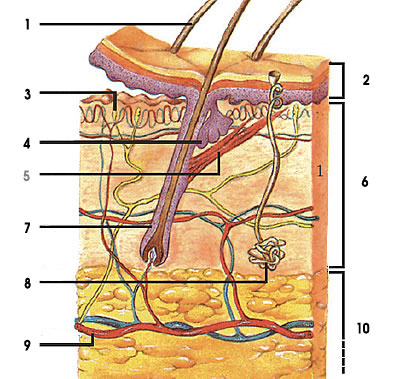 | |
| 1. Hair shaft | 6. dermis |
| Although the skin is assumed to have a simple structure, it truly is a highly complex organ composed of various layers, in which are receptor nerves, circulatory channels, ventilation systems, temperature and humidity regulators, and it can even produce a shield against sun-light when necessary. | |
Think of a tissue metres in length yet integral; let it be a tissue bearing features that provide simultaneously both heating and cooling; firm yet very aesthetic, that can offer a very effective protection against all external effects.
The skin tissue that covers the human body and the bodies of all living beings, with some differences according to species, bears all of these characteristics.
Skin tissue, like many other structures, is an organ important enough that its absence puts human life at risk. The injury of even a section of the skin, leading to a considerable water loss in the body, would cause death. Given this feature, the skin is an organ that refutes the theory of evolution on its own. It is impossible for a living being to survive, which has all of its organs fully formed but its skin not yet evolved or partly formed. This shows us that all the bodily parts of human beings as well as animals have been formed intact and flawless at the same time, that is, they were created.
Beneath the skin, which is made up of totally different structures, lies a layer made up of lipids. This lipid layer has the function of insulation against heat. Above this layer is a section most of which is made up of proteins and which gives the skin its quality of elasticity.
The view we would come across when we look at a centimetre below the skin is a picture formed by these lipids and proteins, with various vessels therein. It is not aesthetic at all, and even terrifying. Covering all these structures, the skin both makes a very aesthetic contribution to our body and it protects us from all external effects, which alone is enough to show how important the existence of our skin is to us.
All of the functions of the skin are vital. Some of these are:
It prevents disturbance of the body’s water balance:
Both sides of the epidermis, the outer layer of skin, are waterproof. Water concentration in the body is controlled by means of this feature of the skin. The skin is a more important organ than the ear, nose and even the eye. We can live without our other sense organs, but it is impossible for man to survive without skin. It is impossible for "water", the most vital fluid of human body, to be retained in the body without the skin.
It is strong and flexible:
Most of the cells of the epidermis are dead. Dermis, on the other hand, is made up of living cells. Later, epidermal cells start to lose their cellular characteristics and are converted into a hard substance called "keratin". Keratin holds these dead cells together and forms a protective shield for the body. It may be thought that its protective quality would increase if it were thicker and harder, but this is deceptive. If we had a skin as hard and thick as that of the rhinoceros’, our highly mobile body would lose this mobility and be clumsy.
Regardless of the species in question, the skin is never thicker than required. There is a very well balanced and controlled plan in the structure of the skin. Let us suppose that epidermal cells constantly died and this process did not stop at a certain point. In this condition, our skin would continue to thicken, and become thick like an alligator’s skin. Yet, this is never the case, the skin is always just thick enough. How does this happen? How do skin cells know where to stop?
It would be very illogical and ridiculous to claim that the cells constituting skin tissue determine where to stop on their own, or that this system came about in a coincidental way. There is a manifest design in the structure of the skin. No doubt, it is Allah, the Sustainer of all the worlds, the One and Only, Who has brought about this design.
It has mechanisms to cool down the body in hot weather:
The dermis is surrounded by very thin capillaries which not only feed the skin, but also check the blood level within it. When body temperature rises, the veins expand and help the excessively warm blood to travel through the outer layer of the skin, which is relatively cooler, and the heat is released. Another mechanism that cools the body down is sweating: the human skin is full of many tiny holes called "pores". These pores reach as deep as the lowest layer of the skin where sweat glands lie. These glands pass the water they take from the blood through the pores and throw it out of the body. The water thrown out uses the body heat to vaporise and this causes coolness.
It retains body heat in cold weathers:
In cold weathers, the activity of sweat glands slows and the veins narrow. This decreases the blood circulation under the skin therefore preventing body heat from escaping.
What all of this shows is that human skin is a perfect organ specially designed to facilitate our lives. Skin protects us, functions as an "air-conditioner", and facilitates easy locomotion thanks to its flexibility. Moreover, it is aesthetic.
Instead of this type of skin, we could well have a thick and coarse skin. We could have an inflexible skin that would crack and split in the event we put on even a few kilograms. We could have skin that would cause us to faint from heat in summer and freeze in winter. However, Allah, Who created us, has covered our body in the most comfortable, serviceable and aesthetic way. For He is "the Creator, the Maker, the Giver of Form." (Surat al-Hashr: 24).
The Heart
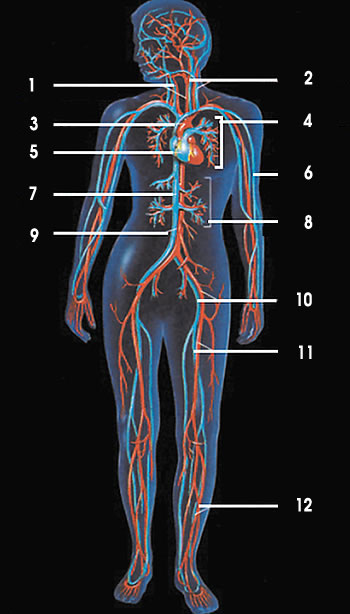 | |
| 1. carotid artery | 2. jugular veins |
| The circulatory system connects each one of the 100 trillion cells in the human body. In the picture, the red capillaries represent blood with high oxygen content and the blue ones represent blood with low oxygen content. | |
The most important component of the circulatory system that connects the 100 trillions cells in the human body one by one, is, without doubt, the heart. With its four different chambers that pump deoxygenated and oxygenated blood to different parts of the body without mixing them with one another, and with its valves that function as safety valves, the heart’s design depends on highly delicate balances.
Our heart, which constantly beats throughout our lives at a certain pace although we do not intervene at all, is one of the clearest pieces of evidence of the Creation.
Starting to beat in the mother’s womb, the heart works, without stopping at all during our entire lifetime, with a rhythm of 70-100 beats per minute. It rests only for half a second between each beat and it beats approximately 100,000 times a day. When a human’s life span is considered, we would come across a figure quite hard to calculate.
All the structures in the heart, which has an extremely delicate order in its operation, are specially designed. In the heart, every detail has been considered: the deoxygenated and oxygenated blood’s not mixing with one another, the regulation of body pressure, the operations required for the delivery of nutrients to the whole body, and the systems that pump blood only as much as needed. The heart is accordingly designed for all of the above.
In the heart, which is a wonder of design, exists a system so complex that it could not by any means have been formed by coincidence. All of these features present us their designer, that is, Allah, the Sustainer of all the worlds, Who creates flawlessly and without an example.
A few features of the heart can be listed:
The heart is placed in one of the most protected places in the body:
By being placed in the rib-cage with a special design, the heart, one of the most important organs, is very well protected against external blows.
Deoxygenated and oxygenated bloods never mix:
In the heart, deoxygenated and oxygenated bloods are in constant motion. A special tissue divides the heart into four chambers with different features. The upper part comprises the right and the left atria, which are filling chambers. They pass the blood to the ventricles below. Thanks to the delicate order here, the bloods never mix with each other.
It regulates the blood pressure in such a way that it does no harm to the organs:
The heart works not like a single pump, but like two adjacent pumps, each of which has its own ventricle and atrium. This separation also divides our circulatory system into two. The right side of the heart sends blood with a relatively lower pressure to the lungs and the left side pumps blood with a higher pressure to the whole body. This pressure regulation is very important, because if the blood sent to the lungs were pumped with the same pressure as the blood sent out around the body, the lungs would be crushed, being unable to stand this pressure. The perfect balance in the heart does not permit such a problem to occur in the lungs, because the heart is flawlessly designed.
It provides for the transportation of many needed materials to the organs:
Clean blood coming from the heart is transmitted to the tissues by the aorta and oxygen is carried to the tissues by the vessels that reach all the cells. During its circulation in the capillaries, blood distributes substances other than oxygen such as hormones, food and other kind of nutrients to the tissues.
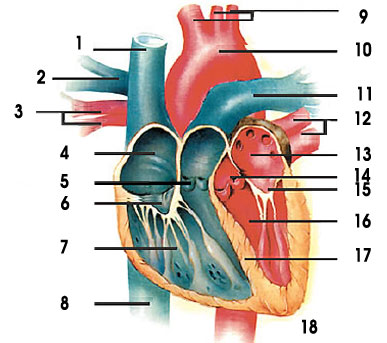 | 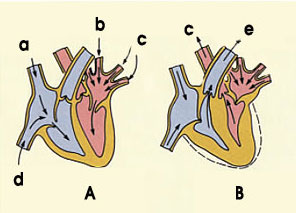 | |
| The heart has an excellent design based on delicate balances, with its four chambers pumping blood to different parts of the body without mixing two different kinds of bloods one with another, and its openings functioning as safety valves. | ||
| 1. superior vena cava | 7. right ventricle | 13. left atrium |
It has valves arranging the direction of bloodstream and working in perfect harmony:
In the heart, there are valves in the mouth of each chamber that prevent the blood from flowing in the reverse direction. These valves between the atria and ventricles are made of fibrous tissues and held by very thin muscles. Since excess blood would leak towards the atriums if one of these muscles stopped functioning, then serious heart disease would occur that would cause even death. We come across with such a condition only in cases of disease. A contrary condition never occurs.
It pumps the required amount of blood depending on changing conditions:
The amount of blood pumped by the heart changes according to the needs of the body. Under normal conditions, the heart beats 70 times a minute. While doing strenuous exercise, during which the muscles need more oxygen, the heart increases the amount of blood it pumps and raises its pace to 180 times per minute. What would happen if this were not so? If the heart were to work at a normal pace when the body needed more energy, the balance would be harmed and the body would be injured. However, no such thing occurs because of the perfect structure of the heart. Without making us obliged to engage in its regulation, the heart regulates the amount of blood to be pumped.
It functions away from our control, yet, exactly as it should:
The amount of blood to be pumped by the heart is controlled by a special nervous system. Whether we are asleep or awake, our nervous system by itself regulates the amount of blood to be pumped and the speed of pumping. The structure of the heart - that regulates without any intervention as to where, when and how blood is needed - is flawless. Since the heart could not have formed this system on its own, or this perfect system could not have formed by coincidence, the heart is created. Allah, Who has infinite knowledge, designed it in the most flawless manner possible.
It operates with a special electrical system:
The muscle which makes the heart beat and which is called the heart muscle, is different from all other muscles in the body. Ordinary muscle cells in the body contract whenever stimulated by the nervous system. However, heart muscle cells contract by themselves. Those cells have the capability of initiating and spreading their own electrical current. Although each cell possesses this capability, none of them contracts independently from the others because then they would function against the instructions of the electrical system controlling them. In other words, they do not cause a chaos that would disturb the regular pace of the heart, in which one part contracts while the other relaxes. These cells, which are found in the form of a chain, act together as per the instruction given by the electrical system. Again, a flawless harmony is at work.
As seen in all of its features, the structure of the heart shows us its flawless design, that is, its "being created", and it thus presents us its Designer. It presents us Allah, the Sustainer of all the worlds, Who is not seen, yet presents Himself to us in everything He has created:
That is Allah, your Lord. There is no god but Him, the Creator of everything. So worship Him. He is Responsible for everything. (Surat al-An’am: 102)
The Hand
 |
| Robot ne kadar gelişmiş olursa olsun gerçek bir elin özelliklerine sahip olamaz. |
Our hands, which enable us to perform some very ordinary acts such as stirring a cup of tea, turning the pages of a newspaper, or writing, are incredible engineering wonders.
The most important feature of the hand is its ability to operate with high efficiency in very distinct activities, despite having a standard structure. Being furnished with a great number of muscles and nerves, our arms help our hands grip objects strongly or softly according to different circumstances. For instance, the human hand, although when not formed into a fist, can strike a blow strike against an object with a weight of 45 kilograms. However, our hand can also feel, between its thumb and forefinger, a sheet of paper one tenth of a millimetre in thickness.
Obviously, these two acts are of a totally different character. As one requires sensitivity, the other requires great force. We, however, never even think for a second what we have to do when we take a sheet of paper between our fingers or hit with a fist. Nor do we think how to adjust the strength for these two acts. We never say, "Now I will pick up some paper. Let me apply a force of 500 g. Now I will lift this bucketful of water. Let me apply a force of 40 kg." We even do not bother to think about these.
The reason is that the human hand is designed to perform all these acts simultaneously. The hand is created together with all its functions and all its related structures concurrently.
All the fingers in the hand are the appropriate length and position, and proportionate to each other. For instance, the strength of a fist formed with a hand having a normal thumb is greater than that formed with a hand having a shorter thumb, because with its pre-determined appropriate length, the thumb covers other fingers and helps augment their power by supporting them.
There are many small details in the structure of the hand: for instance, it has smaller structures besides the muscles and nerves. The nails at the tip of the fingers are by no means trivial accessories. When we try to pick a needle from the floor, we use our nails as well as our fingers. The rough surface comprising our fingertips and nails helps us in picking up small objects. Last but not least, nails play a big role in the regulation of the minute pressure fingers have to exert on the object they hold.
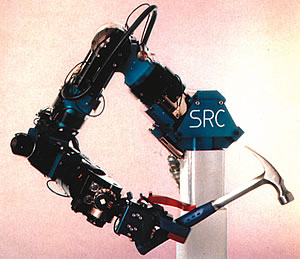 |
Another distinctive feature of the hand is that it does not get tired.
The worlds of medicine and science spend a considerable effort on making an artificial copy of the hand. The robotic hands so far manufactured have the same performance as human hands in terms of power, yet it is hard to say the same thing for sensitivity of touch, perfect manoeuvrability, and the ability to do diverse jobs.
Many scientists agree that no robot hand can be made having the complete functions of the hand. Engineer Hans J. Schneebeli, who has designed the robotic hand known as "The Karlsruhe Hand", stated that the more he worked on robotic hands, the more he admired the human hand. He added that they still need a lot of time to make possible even a certain number of the jobs accomplished by a human hand.
The hand usually functions in co-ordination with the eye. The signals reaching the eye are transmitted to the brain, and the hand moves according to the command given by the brain. These, of course, are completed in a very short time and without making us spend a special effort to do them. Robotic hands, on the other hand, can only rely either on sight or touch. Different commands are needed for every move they make. In addition, robotic hands cannot accomplish diverse functions. For instance, a robotic hand playing the piano cannot hold a hammer, and a robotic hand holding a hammer cannot hold an egg without breaking it. Some robotic hands that have only lately been produced are able to perform 2-3 actions together, but this is still very primitive when compared to the abilities of the hand.
In addition, when you consider that the two hands co-operate with each other in perfect harmony, the flawlessness of the design of the hand becomes more explicit.
Allah designed the hand as an organ especially for human beings. With all these aspects, it shows us the perfection and uniqueness in Allah’s art of creation.
 |
| And in your creation and |
Conclusion
These excellent mechanisms in the human body generally work without our knowledge or awareness of them. The beating of the heart, the functions of the liver, the rejuvenation of the skin are all away from our direct knowledge. The same is true for hundreds of other organs not mentioned here. We are not even aware that our kidneys filter blood, our stomachs digest the food we eat, the movement of our intestines, or the perfect operation of our lungs that help us breathe.
The human being realises the worth of his body only when he is sick and his organs become dysfunctional.
How, then, has this perfect mechanism come into being? It is unquestionably not so difficult for a conscientious person with wisdom to comprehend and feel that this body is "created".
The claim of evolutionists that this body has come into being because of coincidences is ridiculous, because they assert that accumulation of coincidences bring an organism into being. The human body, however, can only function with all its organs intact. A human without a kidney, heart or intestine cannot live. Even if these organs exist, a human cannot survive if they do not function properly.
Therefore, the human body must have come into being as a whole in order to survive and carry on his generation. That the human body has "come into being instantaneously and completely" means that it is "created".
 |
| We created you so why do you not confirm the truth? Have you thought about the sperm that you ejaculate? Is it you who create it or are We the Creator? We have decreed death for you and We will not be forestalled from replacing you with others the same as you and re-forming you in a way you do not know. |
- The Ability to See the Signs of Allah
- Part I: "The Four Animals Emphasised In The Qur’an" - The Gnat
- Part I: "The Four Animals Emphasised in the Qur’an" - The Honey Bee
- Part I: "The Four Animals Emphasised in the Qur’an" - The Camel
- Part I: "The Four Animals Emphasised in the Qur’an" - The Fly
- Part II: "The Human Being" - Creation in the Uterus
- Part II: "The Human Being" - The Mechanisms in Our Body
- Part II: "The Human Being" - The Defence System
- Part III: "The signs in living things" - Professional Hunters
- Part III: "The Signs in Living Things" - Defence Techniques
- Part III: "The Signs in Living Things" - Amazing Architects
- Part III: "The Signs in Living Things" - The Mysteries In The Reproduction of Animals
- Part III: "The Signs in Living Things" - The Migration of Birds
- Part III: "The Signs in Living Things" - Nature and Technology
- Part IV: ''The earth''
- Part V: ''Recent Scientific Findings and the Qur'an''- Verses of the Qur'an and the Universe
- Conclusion
